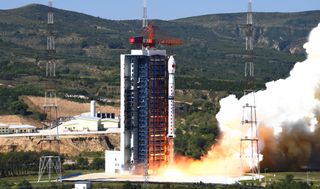China launches hyperspectral Earth observation satellite
China launched the Gaofen 5 (02) hyperspectral Earth observation satellite on Tuesday as the country races towards carrying out 40 missions in 2021.
A Long March 4C rocket lifted off from Taiyuan Satellite Launch Center at 11:01 p.m. EDT Sept. 6 (0301 GMT or 11:01 a.m. local time Sept. 7). Insulation tiles can be seen falling from the payload fairing and uppermost stage as the rocket climbs from the launch pad.
The China Aerospace Science and Technology Corporation (CASC), announced the success of the launch once the satellite had entered its planned orbit. U.S. space tracking reported the satellite to be in a roughly 426 mile (685 kilometers) altitude orbit inclined by 98 degrees.
Video: China launches Earth observation satellite, rocket sheds tiles
Related: China launches 4 satellites on 2 rockets within hours of each other

This so-called sun-synchronous orbit means the satellite will pass the same point on Earth at the same local time each day. Gaofen 5 (02) — the second of two identical Gaofen 5 satellites — was developed by the Shanghai Academy of Spaceflight Technology (SAST), one of the major arms of CASC. The satellite is based on a SAST3000 platform and carries seven instruments for hyperspectral monitoring of the atmosphere, water and land.
Hyperspectral imaging means the satellite will monitor hundreds of very narrow channels of light, from ultraviolet to long-wave infrared, allowing the satellite to produce images indicating the chemical-physical composition of objects in the image.
The new satellite will join other optical and radar remote sensing satellites in the Gaofen series which together form the China High-resolution Earth Observation System (CHEOS). The first CHEOS satellite, Gaofen 1, was launched in 2013. Little is known about newer, higher numbered Gaofen satellites like Gaofen 11, which may have very high-resolution optical imagers.
Get the Space.com Newsletter
Breaking space news, the latest updates on rocket launches, skywatching events and more!
The first Gaofen 5 satellite was launched in 2018. Launch of the new satellite had slipped by a day, according to earlier closure notices indicating a planned launch for 24 hours earlier. No reason for the delay was reported by China.
CHEOS was approved in 2010 with the goal of boosting Chinese satellite imaging capabilities to deliver real-time, all-weather global Earth observation data on land use, environmental and ocean monitoring, disaster response, forecasting and more.
The Long March 4C rocket had its first flight in 2006 and has now flown 36 times with two failures. It uses a toxic hypergolic propellant mix as with China's older generation Long March rockets.
CASC has now launched 30 times in 2021, with all 30 being successful. CASC is preparing to launch the second cargo mission to the Tianhe space station module as well as the crewed Shenzhou 13 mission in October.
The other two launches from China so far this year were conducted by private company iSpace, with both Hyperbola-1 solid rockets failing to reach orbit.
Taiyuan is expected to host the first launch of a new-generation Long March 6A rocket before the end of the year. A new launchpad has been constructed at the center for the rocket.
The new launcher uses liquid oxygen and kerosene unlike older Long March rockets. It will also feature four solid-propellant boosters and will be the first time China combines solid and liquid propellants for a launch vehicle. Both the Long March 4C and 6A are developed by SAST.
Follow us on Twitter @Spacedotcom and on Facebook.
Join our Space Forums to keep talking space on the latest missions, night sky and more! And if you have a news tip, correction or comment, let us know at: community@space.com.

Andrew is a freelance space journalist with a focus on reporting on China's rapidly growing space sector. He began writing for Space.com in 2019 and writes for SpaceNews, IEEE Spectrum, National Geographic, Sky & Telescope, New Scientist and others. Andrew first caught the space bug when, as a youngster, he saw Voyager images of other worlds in our solar system for the first time. Away from space, Andrew enjoys trail running in the forests of Finland. You can follow him on Twitter @AJ_FI.
